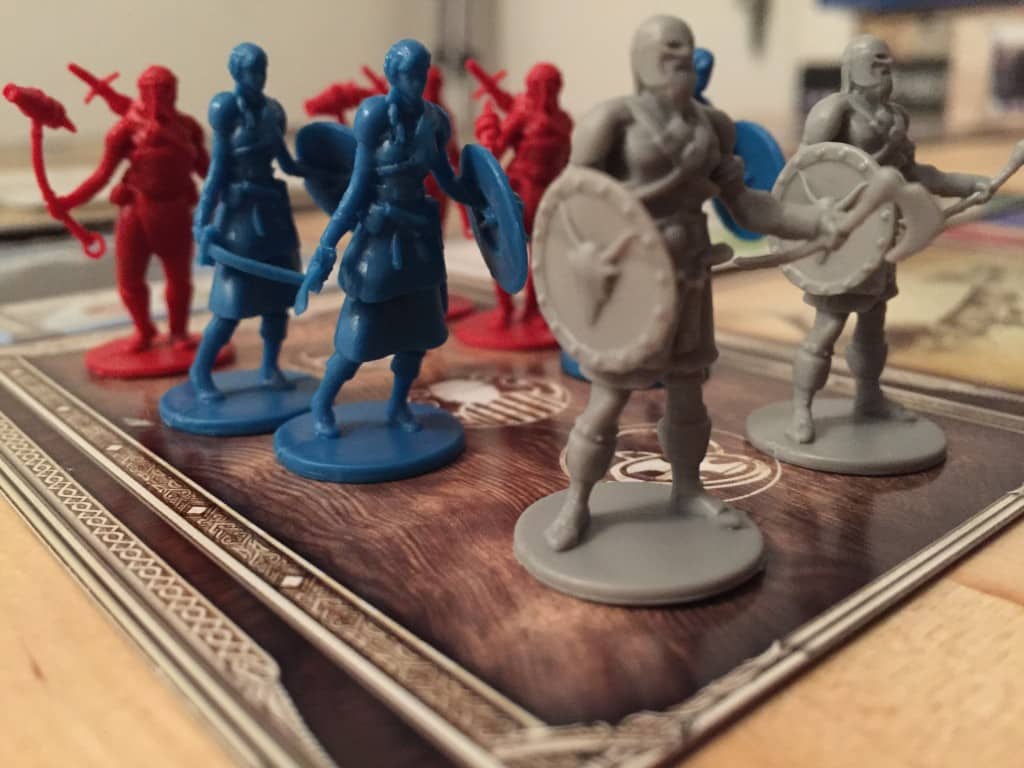Have you noticed there are a lot of Viking games hitting the market of late? No? Maybe it’s just me.
After all, the Norse cultures of the first millennium are ripe for game development. It was a long time ago and yet we have enough historical context to draw from, there is a rich and interesting mythology we can tap into, and the Viking culture in particular was both agrarian and martial. I think I just described a board game.
And in this case, that board game is In the Name of Odin. Recently fulfilled after a successful Kickstarter by NSKN Games, In the Name of Odin, designed by Krzysztof Zi?ba, is a game about Viking chieftains eager to build the most impressive following and take over as the Jarl.
Beautifully constructed and with fantastic components, In the Name of Odin looks like a picturesque entry in Viking games collectors’ shelves, but how does it play? Let’s take a closer look.
How In the Name of Odin Plays
In the Name of Odin at first glance looks like a crunchy game. In actuality, it’s fairly simple to learn and teach, and most games take less than 90 minutes (even with a full complement of players).
Each player will draw a hand of up to 6 cards every round. These cards consist of two symbols – on the top are Viking symbols matched to one of three types of miniature. There are red warriors, blue sailors, and black traders. The bottom symbols match different resources on the board, including the green commerce symbol, purple ship symbol, and yellow hero symbol.
Every card has a combination of those two symbols on it and a certain number of symbols will be needed to perform each action.
For example, to recruit a hero, you’ll need between 2-4 hero symbols (each slot has a different cost). For building ships, you’ll need three ship symbols. To build a building, you’ll need to purchase a building token (which costs one or more green depending on how many other buildings you’ve crafted), as well as spend three commerce tokens to actually build the building.
Each turn you will spend all of the cards you want to spend performing as many actions as you like before passing to the next player. You’ll draw back up your hand when done each time.
The goal of all this? To build up resources on your player board in the form of bonuses, heroes, ships, and Viking miniatures that are all needed to go on raids.
The raid cards are located at the center of the board and anyone can attempt any raid. There are several raid cards that offer bonuses if you can reach them (which requires ships with longer distance). Completing these raids gives you a fair number of points, as well as damage to your ship, losses to your Viking resources, and the potential to lose points if you cannot match cards that your opponents play after your raid.
It’s a tight, fast-paced resource management game in which you get to do only a handful of the things you’d like to do, and it works quite well.
What We Like About In the Name of Odin
In the Name of Odin works well because it is so tightly paced. You won’t be able to build all of the buildings and your ships will almost always have damage. You will miss out on a lot of great heroes, and other players will snipe good raids out from under your nose. And that tight nature and the low scoring finale to the game make for a great experience that has high replayability.
Teaching this game is very quick as well. Essentially everything I wrote above with a few additional details will get people ready to dive into the game, and because everyone finishes their turn in one go, it’s easy to help them work through the first couple of turns.
The game itself is beautiful as well. The board is sweeping and expertly illustrated. While buildings, actions, raids, and ship cards have roughly the same art on each of them, the hero cards are full of fantastic full portraits of Norse men and women of myth and legend. The miniatures, while absolutely not necessary for the type of game this is, are very cool to have. Where most games would have included cubes at the same price point, this one goes the extra mile with a small army of Vikings at your disposal.
Combined with a bit of strategic end game scoring and the luck of the draw component and you have a game with high replayability.
Issues with In the Name of Odin
If I had to cite one issue with this game, it’s that it gives people the wrong impression. A look at the box or the game setup on the table can either attract or turn people off for the wrong reason. This is a card-based resource management game in which there is very little player interaction (save for some challenges you throw at each other), and limited availability of key components. It’s a tableau builder that forces you to make decisions or avoid access to key components later in the game.
I like all of that, but at first glance, it looks like an area control miniatures-based game. People think it’s a more euro-y Blood Rage and it’s far from that. Additionally, because the game is so tight with resources, it can be tough to catch up if you fall behind early in a game with a larger player count. If someone at the table gets 3 raids under their belt early and you have none in a 4-5 player game, good luck catching up. The short play time helps to mitigate this, but more than one player was disappointed in our different plays because of an early fall behind.
The Bottom Line
Even with all that said, In the Name of Odin is a fantastic game that works quite well in what it attempts. It is a fast, tightly-paced hand management and resource game and while the components are a bit overdone, I will never complain about getting extra miniatures and beautiful artwork in a game.
If you are a fan of Viking games, mid-weight euros that clock in under 90 minutes, or resource and points-tight games, check this one out. It can be imported from some sites that offer import games or that backed the Kickstarter as a retailer, and here’s hoping for a US release in the near future.
Editor’s Note: A review copy of the Kickstarter Edition of In the Name of Odin was supplied for the purposes of this review.
SCORE
8.0
Buy
REVIEW
8

